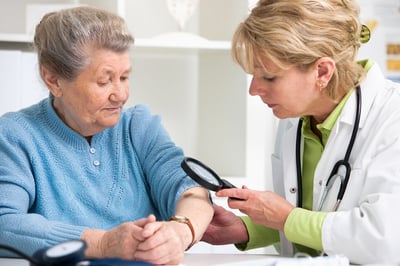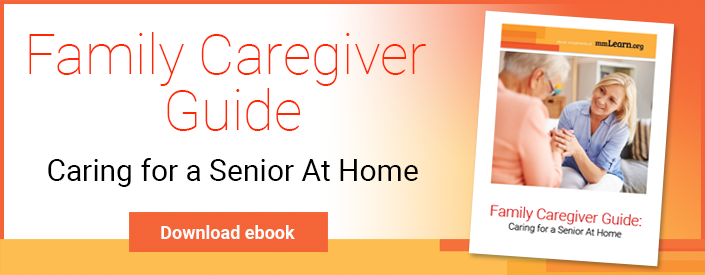 Our bodies change as we age, and the risk of developing skin-related disorders increases.
Our bodies change as we age, and the risk of developing skin-related disorders increases.
Without prompt diagnosis and treatment, skin ailments can not only be painful and irritating, but may also affect the health and quality of life for seniors.
What are the most common aging skin problems?
And how can caregivers help identify and assist our loved ones in getting treatment and relief?
Treating Dry Skin
Aging skin is particularly vulnerable to dryness. That’s not necessarily a problem unless it causes itching.
If your aging loved one’s skin is scaly, flaky, rough, or cracked, it could indicate a dry skin condition called xerosis. There are a few reasons for this: As we age, our skin cells don’t regenerate as often. We have a thinner epidermal layer, and our skin doesn’t retain moisture as well as it used to.
Dry skin can be treated with over-the-counter or prescription medications. If your loved one has dry skin or is bothered by itching, caregivers can work with a dermatologist to solve the problem.
Detecting Skin Cancer
Skin cancer is the most common cancer in the United States.
As many as 50 percent of Americans over the age of 65 develop at least one skin cancer over the course of their lives. While older white men are at particular risk, everyone is vulnerable to this deadly disease.
It’s important for people to visit a dermatologist regularly so they can do a thorough examination and check for new moles, other growths, or skin changes that may indicate skin cancer. The most common skin cancers are basal cell carcinoma and squamous cell carcinoma.
No matter what age we are, we still have to protect ourselves from the sun’s dangerous rays. A dermatologist can also recommend ongoing preventive measures, such as wearing protective clothing and regularly applying sunscreen.
When it comes to skin cancer, early detection is key, and a trip to the dermatologist may save your aging loved one's life.
10 Common Aging Skin Problems
In this mmlearn caregiver video, Dr. Rebecca Kelso and Dr. Emily Fridlington, both board-certified dermatologists, explore the 10 most common skin issues for seniors.
-
Nail Fungus (onychomycosis). This is most common in toenails, but fingernails can also be affected. Nails get thicker and discolored (yellow, white, brown, or green). They can also become brittle or flaky and peel off. It can be treated with oral or topical medications.
-
Seborrheic Dermatitis is a common form of mild eczema where people get red, itchy skin patches. Common areas include the scalp, behind the ears, face, chest, or genital area. It’s caused by sebum, a product produced in the oil glands that is related to a common yeast that lives on the skin called malassezia. It can become very itchy, and some people are bothered by the appearance, especially on the face. There are topical medications like hydrocortisone and Lotrimin antifungal cream that can be mixed.
-
Warts (verrucae vulgaris). Warts are caused by a common virus called human papillomavirus. These are not the same kinds of warts that have been linked to cervical cancer. They are thick, elevated spots that often appear in sites of trauma: fingers, hands, knees, elbows, and feet. There are many over-the-counter and home remedies for warts. Or doctors can remove them with liquid nitrogen cryotherapy.
-
Shingles (herpes zoster) is a painful condition that is in the herpes family of viruses. It is a reactivation of chicken pox that occurs in about 20 percent of healthy adults and in 50 percent of people who are considered immunocompromised. Shingles causes numbness, burning, tingling, itching, or intense pain, and sometimes blisters appear. Shingles can be treated with antiviral therapy, and it is best to get diagnosed and treated early to stop it from progressing into more dangerous conditions. All people older than 60 should be vaccinated against shingles, even if they had chickenpox when they were young.
-
Xerosis (dry skin). Luckily, this is one of the easiest skin conditions to treat by avoiding harsh soaps or cleansers and heavily fragranced products and using creams or ointments (emollients). The dermatologists in the video recommend avoiding lotions, though. If you can unscrew the cap and turn the container upside down and the product doesn’t come out, it’s thick enough to put on your skin.
-
Actinic Purpura (bruising). Our skin gets more fragile as we age, in large part because our blood vessels rupture after years of sun damage. Some medications like aspirin, Advil, or blood thinners can make it worse. Most bruises are not dangerous, and there are some remedies like DerMend available that can help form a barrier.
-
Actinic Keratosis. This is another condition that is a result of sun exposure. It shows up as rough, scaly patches on the face, lips, ears, forearms, scalp, neck, or back of the hands. These patches can become cancerous, so doctors often recommend removing or treating them with topical medicines, liquid nitrogen, or other in-office procedures.
-
Seborrheic Keratosis. These are common benign growths that appear in different colors (gray, brown, pink). They can be found anywhere on the body, often in areas of friction. They can be frozen off, but no treatment is necessary.
-
Intertrigo. This is another common condition where pink patches show up in areas where the skin folds: under the breasts or tummy. It’s usually a mixture of yeast overgrowth and moisture. So maintaining a healthy body weight helps, as does keeping the areas dry. It can also be helped by the combination of over-the-counter hydrocortisone and Lotrimin.
-
Stasis Dermatitis. This is a form of eczema/inflammation that develops in the lower legs, often near the ankles. It is caused by circulation problems, varicose veins, or heart disease. The leg veins aren’t doing a good enough job pushing the blood back to the heart. It’s treated by leg elevation, compression stockings, and topical steroids.
Tools for Caregivers
Attentive caregivers can help their aging loved ones protect their delicate skin from further sun damage. They can also help identify skin problems and learn which conditions can be treated at home and which ones require professional medical help.
Of course, regular visits to a dermatologist can provide pain relief for minor ailments and help detect and treat more serious conditions.
Luckily, there are many helpful resources available for caregivers who are assisting seniors aging at home or in care facilities.
Together we can protect our elders’ delicate skin and bodies to help them age with dignity and in comfort.

